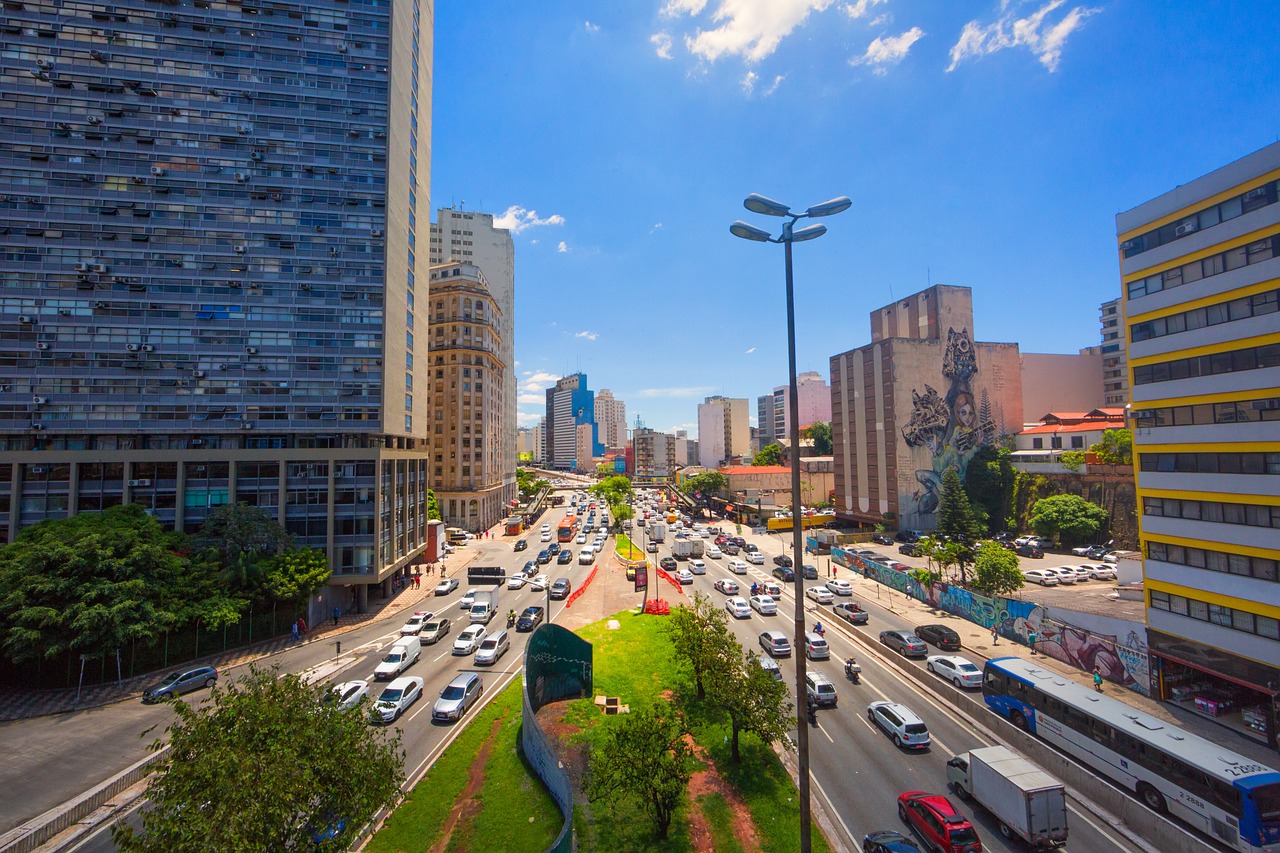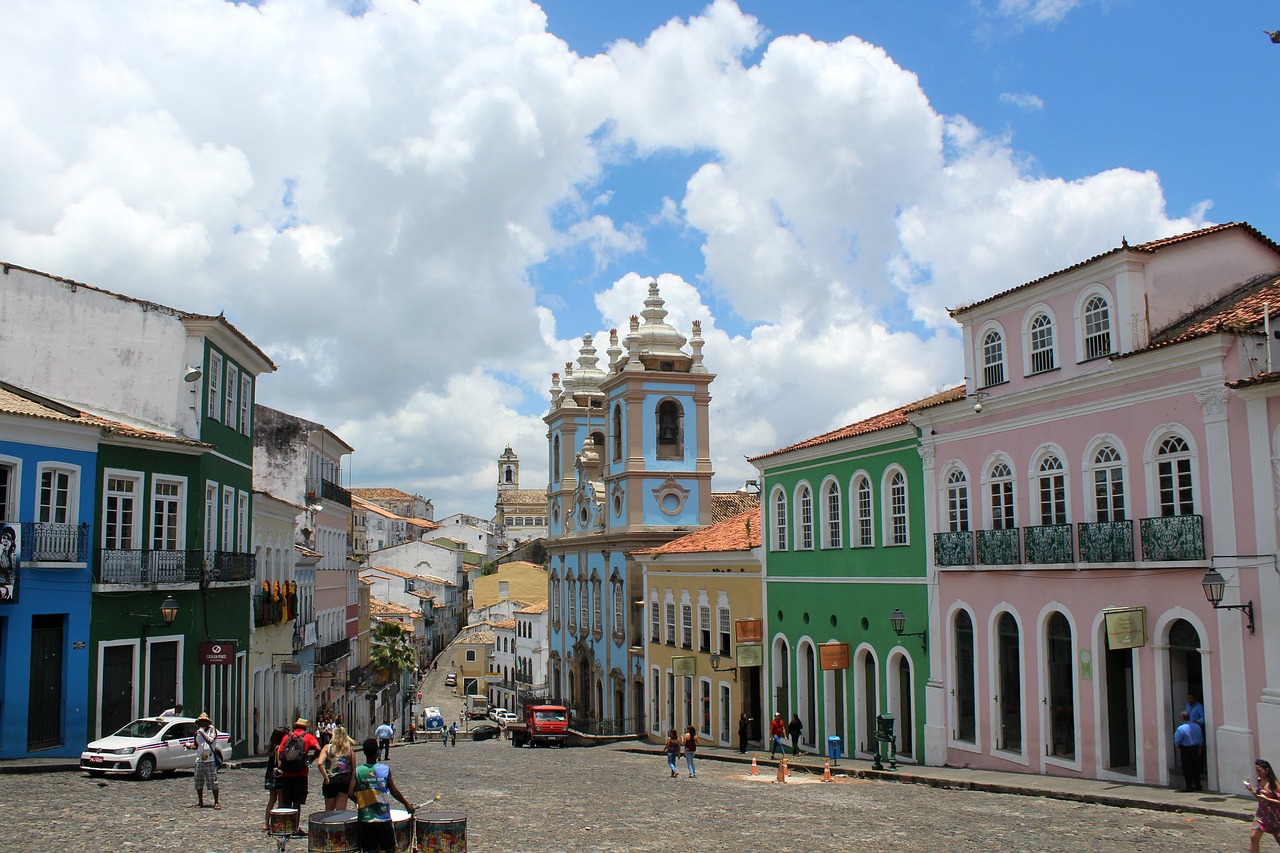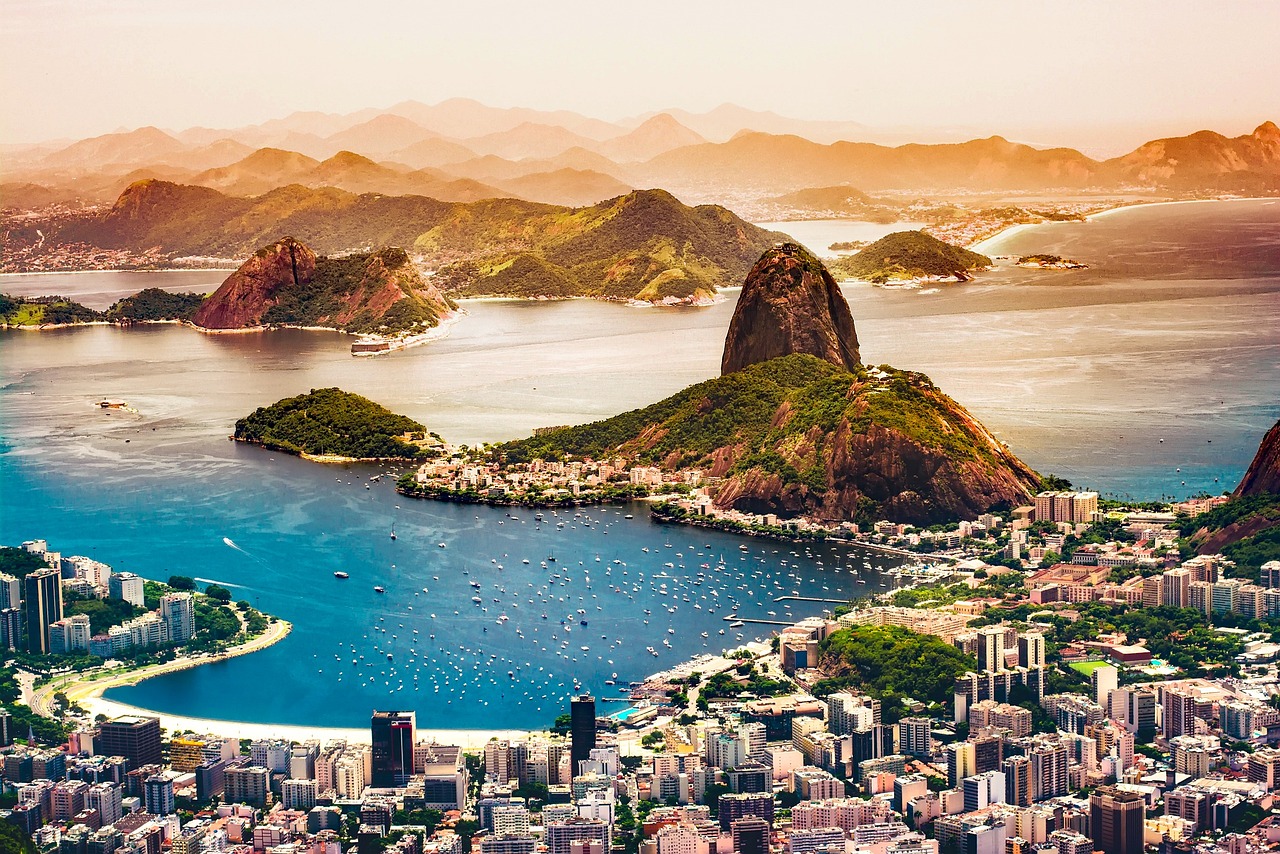São Paulo is a city located in southeastern Brazil and is the largest city in the country, as well as the capital of the state of São Paulo. It is known for its vibrant cultural scene, diverse population, and bustling economy. São Paulo is located about 70 kilometers (43 miles) inland from the Atlantic Ocean and sits on the Brazilian Highlands plateau.
Short History
São Paulo is a city located in southeastern Brazil and is the largest city in the country. It was founded in 1554 by Jesuit priests and was originally named São Paulo dos Campos de Piratininga. The city began as a small village and grew rapidly during the 19th and 20th centuries as it became a center for coffee production and trade. Today, São Paulo is a major economic and cultural center, known for its vibrant art scene, diverse population, and impressive skyscrapers.
Architecture
São Paulo has a diverse architectural landscape that reflects the city’s history and economic development. The downtown area features many historic buildings from the early 20th century, such as the Theatro Municipal and the Edifício Martinelli. The city also has a number of impressive modernist buildings, including the São Paulo Museum of Art and the Copan Building, which is a large residential complex designed by Oscar Niemeyer. In recent years, there has been an increase in contemporary architecture, with the creation of the Museum of the Portuguese Language and the São Paulo Museum of Image and Sound, both designed by Brazilian architect, Paulo Mendes da Rocha.
Museums and Galleries
Here are some of the most interesting museums and galleries in São Paulo:
- São Paulo Museum of Art (MASP) – known for its unique architecture, this museum features an impressive collection of European and Brazilian art.
- Pinacoteca do Estado de São Paulo – one of the oldest art museums in São Paulo, featuring a collection of Brazilian art from the 19th century to the present.
- Museum of the Portuguese Language – an interactive museum dedicated to the Portuguese language and its impact on Brazilian culture.
- Museum of the Football (Museu do Futebol) – located in the Pacaembu Stadium, this museum celebrates the history and culture of Brazilian football.
- Afro Brasil Museum – dedicated to African and Afro-Brazilian culture and history, this museum features exhibitions, performances, and educational programs.
- Museum of Image and Sound (MIS) – a multimedia museum featuring exhibitions, film screenings, music shows, and other cultural events.
- Museum of Contemporary Art of the University of São Paulo (MAC USP) – one of the largest and most important contemporary art museums in Brazil, featuring works by Brazilian and international artists.
- São Paulo Cultural Center (Centro Cultural São Paulo) – a multi-purpose cultural venue with art galleries, theaters, music venues, and other facilities.
- Japanese Immigration Memorial (Museu da Imigração Japonesa) – a museum and cultural center dedicated to the history of Japanese immigration to Brazil.
- Museum of the Person (Museu da Pessoa) – a unique museum that collects and exhibits personal stories and experiences, aiming to document and celebrate the diversity of human life.
These are just a few examples of the many museums and galleries that São Paulo has to offer.
Landmarks and Monuments
- São Paulo Cathedral: This neo-gothic cathedral located in the heart of São Paulo’s city center was built between 1913 and 1954 and is considered one of the city’s most important landmarks.
- The São Paulo Museum of Art: Known as MASP, this museum is famous for its impressive collection of European art, including works by Van Gogh, Rembrandt, and Picasso.
- The Municipal Market of São Paulo: This market, also known as the Mercadão, is a popular destination for both locals and tourists, with stalls selling a wide variety of fresh produce, meat, and other food items.
- The São Paulo Museum of Modern Art: This museum features a wide range of modern and contemporary Brazilian and international art, including paintings, sculptures, and multimedia installations.
- Ibirapuera Park: This large park is considered the “Central Park” of São Paulo, with walking and biking trails, lakes, and a variety of cultural institutions, including the São Paulo Museum of Modern Art and the Afro-Brazil Museum.
- Monument to the Bandeiras: This iconic monument located in the city center pays tribute to the Bandeirantes, the 17th-century explorers who helped expand Brazil’s borders.
- Martinelli Building: Completed in 1929, this historic skyscraper was the tallest building in South America at the time of its completion and is now considered a symbol of São Paulo’s growth and development.
- Banespa Building: Another iconic skyscraper in the city center, the Banespa Building was completed in 1947 and offers stunning views of the city from its observation deck.
- São Paulo Cultural Center: This large cultural complex features a variety of performance spaces, galleries, and museums, including the Museum of the Portuguese Language.
- Paulista Avenue: This major thoroughfare is considered one of São Paulo’s most important landmarks, with numerous shops, restaurants, and cultural institutions, including the São Paulo Museum of Art and the Itaú Cultural Center.
Parks and Green Spaces
São Paulo has many parks and green spaces, some of which are:
- Ibirapuera Park: This is one of the largest urban parks in São Paulo and a popular spot for jogging, cycling, and picnics. It also features several museums, including the Museum of Modern Art.
- Parque da Luz: Located in the city center, this park is home to several historic buildings and monuments, including the Luz Station and the Portuguese Language Museum.
- Aclimação Park: This park is known for its beautiful gardens and lake, as well as its jogging and cycling trails.
- Villa-Lobos Park: This park is named after the famous Brazilian composer Heitor Villa-Lobos and features a large lake, several playgrounds, and a cultural center.
- Cantareira State Park: Located on the outskirts of São Paulo, this park is one of the largest urban forests in the world and is home to several hiking trails and waterfalls.
- Burle Marx Park: Designed by the famous Brazilian landscape architect Roberto Burle Marx, this park features several gardens and sculptures.
- Parque da Juventude: This park is located on the site of a former prison and now features several cultural and sports facilities, including a skate park and a rock climbing wall.
- Pico do Jaraguá State Park: Located on the highest peak in São Paulo, this park offers panoramic views of the city and features several hiking trails and a visitors center.
- Parque Buenos Aires: This park is known for its beautiful Art Deco buildings and is a popular spot for jogging and outdoor concerts.
- Parque do Carmo: This park is located in the eastern part of São Paulo and features several gardens, a lake, and a Japanese Pavilion. It is also home to an annual cherry blossom festival.
Shopping Districts
São Paulo, Brazil is known for its extensive shopping options, with a wide variety of districts catering to different tastes and budgets. Here are some of the most popular shopping districts in São Paulo:
- Avenida Paulista: This is one of the most famous and busiest streets in São Paulo, known for its financial and cultural importance. The avenue is home to many shopping malls, including the popular Shopping Paulista and the Shopping Cidade São Paulo.
- Rua Oscar Freire: This is a fashionable street that attracts wealthy shoppers, with many luxury boutiques and high-end shops. It is considered one of the most sophisticated shopping districts in São Paulo.
- Rua 25 de Março: This is a busy and crowded shopping district that is known for its affordable prices. The street is packed with vendors selling a variety of products, including clothes, accessories, and souvenirs.
- Shopping Ibirapuera: This shopping mall is located near the Ibirapuera Park and offers a variety of shopping and entertainment options. It has a large food court and a movie theater.
- Shopping Morumbi: This shopping mall is located in the upscale Morumbi neighborhood and offers a wide range of stores, including international brands. It also has a large food court and a movie theater.
- Galeria do Rock: This is a shopping center that specializes in music and alternative fashion. It is known for its collection of vinyl records and punk, rock, and metal fashion.
- Mercado Municipal: This is a traditional market in São Paulo that is known for its fresh produce, meats, and seafood. It also has many food stalls where visitors can try traditional Brazilian cuisine.
- Bom Retiro: This is a shopping district that is known for its many clothing stores, especially for those looking for wholesale and discounted prices.
- Brás: This is another shopping district that specializes in clothing, with many stores selling wholesale and discounted items.
- Eldorado: This is a large shopping mall located in the west of São Paulo that offers a variety of stores, restaurants, and entertainment options.
Food and Drink
São Paulo is known for its diverse culinary scene and offers a variety of traditional dishes and drinks to try. Here are some of the must-try food and drinks in São Paulo:
- Feijoada: a hearty stew made with black beans, various cuts of meat, and vegetables.
- Pão de queijo: small cheese bread balls that are crispy on the outside and soft on the inside.
- Brigadeiro: a popular chocolate dessert made with condensed milk, cocoa powder, and butter.
- Caipirinha: Brazil’s national cocktail made with cachaça (a sugarcane-based liquor), sugar, and lime.
- Coxinha: a savory snack made with shredded chicken and shaped like a teardrop, then coated in dough and deep-fried.
- Pastel de feira: a crispy fried pastry filled with various fillings, such as meat, cheese, and vegetables.
- Churrasco: a Brazilian-style barbecue that features various cuts of meats, such as beef, pork, and chicken.
- Açaí bowl: a refreshing and healthy snack made with açaí berries, topped with granola, fruit, and honey.
- Empada: a savory pastry filled with various fillings, such as chicken, cheese, and shrimp.
- Cuscuz paulista: a dish made with couscous, sardines, and vegetables.
These dishes and drinks can be found in many restaurants and cafes throughout São Paulo, including traditional Brazilian eateries, upscale restaurants, and street food vendors.
Transportation
São Paulo, being the largest city in Brazil, has a complex and varied transportation system. The best ways to move around the city are:
- Metro: The São Paulo Metro is the most efficient and fastest way to move around the city. It covers many areas of the city, including the downtown, the main avenues, and tourist attractions. The metro system is open from 4:40 a.m. to midnight, Monday to Saturday, and from 6 a.m. to 11 p.m. on Sundays and holidays.
- Bus: São Paulo has an extensive network of buses that covers almost every corner of the city. The buses are cheap and operate 24 hours a day. However, they can be crowded, especially during rush hours.
- Taxi/Uber: Taxis and Uber are widely available in São Paulo. Taxis can be hailed on the street, or you can book one through an app. Uber is also widely available and can be booked through the app. Both taxis and Uber are safe and relatively cheap.
- Bicycle: São Paulo has a bike-sharing system called “Bike Sampa,” which is available 24 hours a day. It’s an affordable and eco-friendly way to move around the city. You can also rent a bicycle at several locations throughout the city.
- Walking: If you’re staying in the central areas of São Paulo, walking can be a good option. The city center is quite compact, and walking is a great way to explore the sights and sounds of the city.
City Safety
São Paulo is generally considered to be a safe city, but it is important to take precautions as with any major metropolitan area. As with most cities, crime tends to be higher in certain areas, particularly those with high levels of poverty. It is generally advisable for visitors to stay in well-lit and busy areas, particularly at night, and to avoid displaying valuables in public. Additionally, it is recommended to use licensed taxis or ride-hailing services rather than hailing a random taxi on the street. Overall, if visitors exercise common sense and take precautions, São Paulo can be a safe and enjoyable destination.
Expensive or Cheap
São Paulo is considered one of the most expensive cities in Brazil. The cost of living in São Paulo can be quite high, particularly when it comes to housing and transportation. However, it’s also possible to find affordable options for food, shopping, and entertainment if you know where to look. Overall, São Paulo can be an expensive city to live in, but it offers a wide range of opportunities and experiences that can make it well worth the cost for many people.
Best Time to Travel
The best time to travel to São Paulo is during the months of March to May or August to November. These months offer mild temperatures and lower chances of rain, making it ideal for outdoor activities and sightseeing. The summer months from December to February can be hot and humid with frequent rainfall, while the winter months from June to July can be chilly and rainy. However, São Paulo is a year-round destination and visitors can enjoy the city’s cultural events and attractions throughout the year.
Date Ideas
Here are some date ideas in São Paulo:
- Visit the São Paulo Museum of Art: The São Paulo Museum of Art is a great place to spend an afternoon exploring the galleries and exhibitions. The museum features a wide range of works, including paintings, sculptures, and photographs from local and international artists.
- Explore the Pinacoteca do Estado de São Paulo: Another great museum to explore is the Pinacoteca do Estado de São Paulo. This museum is housed in a beautiful 19th-century building and features a collection of Brazilian art from the 19th and 20th centuries.
- Wander around Ibirapuera Park: Ibirapuera Park is a beautiful green space in the heart of São Paulo. It’s a great place to go for a walk, have a picnic, or rent a bike and explore the park’s many trails.
- Take a cooking class: São Paulo is known for its incredible food scene, so why not take a cooking class with your partner and learn how to make some local dishes together? There are many cooking schools and classes to choose from in the city.
- Enjoy a concert or show: São Paulo has a thriving music and arts scene, with many concerts and shows happening every night of the week. Check out the schedules at venues like the Teatro Municipal or the Cine Joia to see what’s on.
- Visit the São Paulo Zoo: The São Paulo Zoo is a great place to spend a day with your partner, checking out the many animals on display. The zoo is home to over 3,000 animals and is one of the largest zoos in Brazil.
- Take a walking tour: São Paulo is a city with a rich history and culture, so why not take a walking tour to learn more about its past and present? There are many tours available that will take you through the city’s historic neighborhoods and landmarks.
- Go on a street art tour: São Paulo is known for its vibrant street art scene, with murals and graffiti adorning many buildings throughout the city. Take a guided tour to see some of the most impressive works and learn about the artists behind them.
- Visit the Municipal Market: The Municipal Market is a bustling market filled with vendors selling fresh produce, meats, cheeses, and more. It’s a great place to go with your partner to try some local foods and pick up ingredients for a home-cooked meal.
- Take a day trip to nearby towns: If you have some extra time, consider taking a day trip to one of the nearby towns outside São Paulo. Places like Campos do Jordão, São Roque, and Santos are all within a few hours’ drive and offer beautiful scenery and attractions to explore.
Fun and Interesting Facts
Here are some fun and interesting facts about São Paulo:
- São Paulo is the largest city in Brazil and the Southern Hemisphere.
- The São Paulo Museum of Art, also known as MASP, is one of the most important museums in Latin America.
- The São Paulo Cathedral is one of the largest Gothic cathedrals in the world.
- São Paulo is known for its vibrant nightlife and is home to some of the best bars and nightclubs in the country.
- The São Paulo Fashion Week is one of the biggest fashion events in the world, attracting designers, models, and fashion enthusiasts from around the globe.
- São Paulo is home to a large Japanese community, and the district of Liberdade is known for its Japanese restaurants and shops.
- The city has one of the largest helicopter fleets in the world due to the heavy traffic and congestion.
- São Paulo is the economic powerhouse of Brazil and is responsible for nearly a third of the country’s GDP.
- The city is known for its street art scene and has many colorful murals and graffiti throughout its neighborhoods.
- São Paulo hosts the annual São Paulo International Film Festival, which attracts filmmakers and cinema enthusiasts from around the world.
In conclusion, São Paulo is a vibrant and dynamic city with a rich culture and history. From its world-class museums and landmarks to its bustling nightlife and street art scene, there is always something to discover and explore in this fascinating city.



